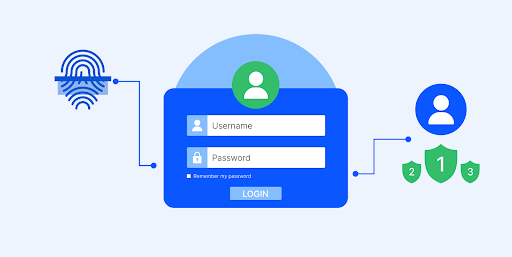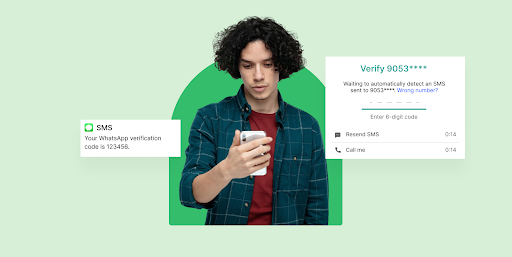SMS verification codes can significantly enhance your security measures, providing a quick and effective way to verify a user’s identity. Integrating text message verification codes into your authentication process can save time, streamline workflows, and strengthen user trust.
Plivo’s Verify API makes it easy to start sending one-time passcodes (OTPs) in one second or less. In this guide, we’ll explain why SMS verification is so effective and show you how to set it up in just 5 minutes. Our API allows you to send your first OTP in 90% less implementation time than a legacy verification solution. We'll also provide step-by-step instructions to ensure you can quickly and easily incorporate one-time passcodes (OTPs) into your applications.
Why should I use SMS verification codes?
While SMS verification isn't foolproof, it's a widely used and convenient security measure. One-time passcodes delivered via SMS or voice add an extra layer of security to online accounts, making them more difficult to break into. Accounts with one-time passcodes enabled as part of two-factor or multi-factor authentication make it much harder for hackers to break in, even if they steal your password.
Financial institutions, e-commerce sites, streaming platforms, and delivery apps. For instance, SMS verification can confirm that the person logging into a peer-to-peer payment platform is the account owner. This can help prevent unauthorized purchases or account takeovers.
Prerequisites to send one-time passcodes
Before we dive in, make sure you complete the following requirements:
1. Plivo account: Sign up for a Plivo account if you still need to do so.
2. API key and token: Obtain your Plivo API key and token from the Plivo console.
3. Phone numbers: Ensure you can access the phone numbers to which you intend to send verification codes.
4. Programming environment: Set up your programming environment with the necessary libraries to interact with the Plivo API. Install the Plivo SDK for your programming language: Plivo supports Python, JavaScript, Ruby, and many more languages.
In summary, make sure you have a Plivo account with an application created. While creating the application, define the right session expiry, attempt, OTP length, etc. You will also need to get a library/module/SDK for making HTTP requests to Plivo's API (this is available in various programming languages) or directing HTTP requests to Plivo’s API.
With these prerequisites in place, here’s how to start sending OTPs.
Create a session
Plivo’s Verify API can be used with Python, Ruby, Node, GO, PHP, .Net, Java. This article will focus on Python.
Step 1: Install Plivo SDK
First, you need to install the Plivo SDK for your programming language. For Python, you can use pip:
Step 2: Configure Plivo Client
Initialize the Plivo client using your Auth ID and Auth Token:
Step 3: Send the OTP
Create a Verify session for sending OTP:
Arguments:
- recipient (string): The phone number to which the message is to be delivered. It's a mandatory parameter.
- app_uuid (string): The UUID of the application you want to use for this session. Defaults to the UUID of the default application for your account.
- otp: You can specify the OTP in the request if you want to send a custom one instead of a system-generated one.
- channel (string): The channel you want to send the code. Allowed values: sms, voice. Defaults to sms.
- locale: The locale parameter allows you to customize the language of the OTP message. This is useful if your users are in different regions and prefer different languages.
- url: To receive a callback on the final state of OTP delivery.
- method: The HTTP method to be used when calling the URL defined above.
If you created multiple applications, you can send the app_uuid in the request parameter:
If you are sending a custom OTP:
If you want to send the locale parameter:
Validate the session
Once the user receives the OTP, they must provide it to your application. You can then verify the OTP using the validate request:
You can request the Plivo support team to configure the hashmap so that the OTP will be automatically read from the message, eliminating the need to enter the received OTP on the handset.
Arguments:
- otp (string): The OTP that you want to validate against a particular session.
- session_uuid: The session UUID of the Verify session request.
Get and list Verify sessions
You can retrieve details of a specific Verify session or list all Verify sessions. This can be useful for auditing and tracking purposes.
Start sending SMS verification codes with Plivo
While there are plenty of ways to improve the security of your application and protect customers from fraud, a lot depends on your service provider.
If you’re looking for a reliable and trusted partner, Plivo is the right solution for you. We send messages to audiences in 220+ countries and offer a full suite of products including SMS API, Verify API, WhatsApp Business API, Voice API, and more.
Interested in reading more about how Plivo can help you strengthen your application’s security? Check out some of our top picks:
- How to Add Two-Factor Authentication to a Python Flask Application with Plivo: A step-by-step guide for Python developers.
- Adding Two-Factor Authentication to a .NET Application: Learn how to integrate OTP verification in .NET.
- Implementing Two-Factor Authentication in Ruby: Ruby developers can follow this detailed tutorial.
- Verify API Reference Documentation: Comprehensive documentation for developers looking to dive deep into Plivo's Verify API.
Preventing SMS Fraud with Plivo: Learn how Plivo’s Verify API protects against SMS fraud.
Conclusion
By following these steps, you can easily integrate Plivo’s Verify API into your application to manage OTPs for user verification. This process ensures a higher level of security and helps authenticate users effectively.
That’s it! You should be ready to start sending OTPs for account verification. For full details regarding setting up OTPs with Verify, check our developer resources.









